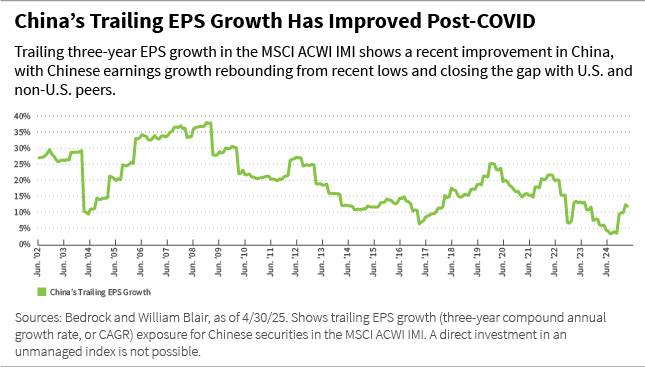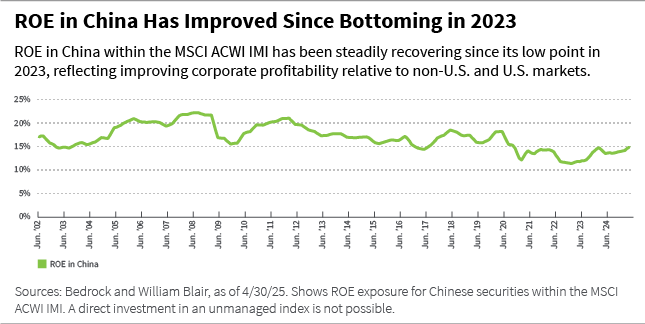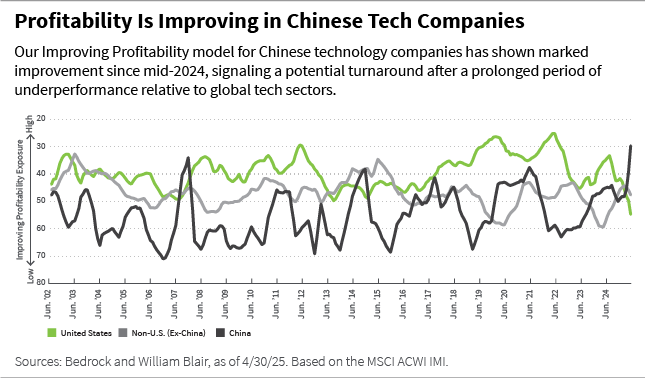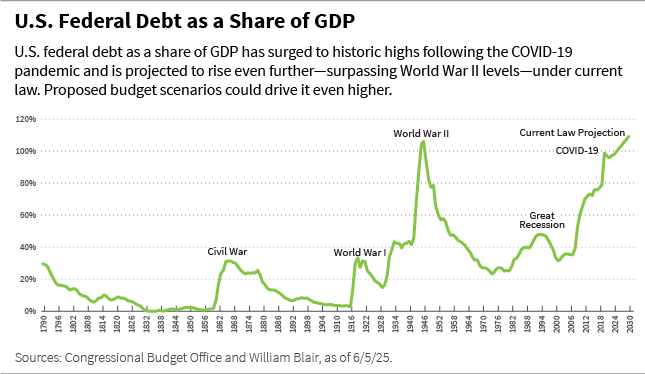July 22, 2025 | Global Equity
Three Global Shifts Favoring Non-U.S. Markets

We believe several forces—tariffs that weigh on U.S. household income, shifts in fiscal and economic policy abroad, and evolving macroeconomic conditions—could compress growth differentials between the United States, Europe, Japan, and China. As a result, the valuation per unit of growth equation looks increasingly favorable for markets outside the United States, potentially supporting greater capital flows into non-U.S. equities.
Force No. 1: Tariffs
We expect U.S. households to absorb the bulk of price increases resulting from tariffs, and higher prices should erode purchasing power and curb consumption by U.S. consumers. Broadening tariffs to progressively more products will likely hit U.S. consumers harder than consumers abroad, leading to a contraction in domestic demand. Although reduced U.S. consumption may affect the revenues of non-U.S. exporters, many non-U.S. jurisdictions are benefiting from tailwinds, making us believe now is an exciting time to invest outside the United States. For example, the U.S. tariffs announced on “Liberation Day,” though delayed, have moved the effective U.S. tariff rate to about 20%, a level last seen in the early 1900s. Even with a 90-day pause on the reciprocal tariffs, the increase leaves the effective rate at a nearly 100-year high. The likely outcomes include slower U.S. growth, higher U.S. inflation, slower-than-anticipated interest-rate cuts (but lower long-term interest rates), and a weaker U.S. dollar. In addition to direct retaliation, other countries are expected to increase trade barriers to prevent the dumping of goods originally destinated for the United States, reinforcing a global shift toward “country-first” policies globally and accelerating fragmentation in global trade.
Force No. 2: Shifts in Fiscal and Economic Policy Abroad
Amid shifting global dynamics, both Europe and China are redefining their approaches to growth. In Europe, sluggish economic performance is increasingly viewed as a national security risk, prompting a shift toward investment-driven, demand-oriented policy. Meanwhile, China is moving to reverse fiscal drag and double down on industrial self-sufficiency, with early signs of recovery visible in earnings and return metrics. While the drivers differ, both regions are signaling a renewed commitment to growth—offering potential opportunities for globally diversified investors.
Europe’s Growth Mandate
European policymakers have increasingly framed the region’s weak growth as a national security concern. The absence of a unified growth and competitiveness strategy has hindered the EU’s ability to invest meaningfully in its own defense (in an increasingly unstable geopolitical environment), enhance economic resilience in the face of trade wars, and address issues of climate change and the ongoing energy transition. Over the past year, however, we have seen growing momentum—and concrete steps—across EU member states to address these issues. For example, Germany’s recent election and the suspension of its debt brake mark a significant shift toward more pro-growth policymaking in the region. More broadly, Europe appears to be moving away from its traditional export-led model toward one focused on attracting capital and stimulating domestic demand. Since the global financial crisis, Europe has experienced sustained capital outflows—most notably from Germany, where companies have invested €1.7 trillion abroad since 2010, often shifting operations to more dynamic economies such as China. Now, Europe may be reconsidering that trend. Could Chinese firms be allowed to take over idle European auto plants or enter joint ventures on European soil? Such a shift would help keep capital within the region and redirect excess manufacturing capacity from China into Europe—potentially easing inflationary pressures in the process. Meanwhile, the recent decline in the U.S. dollar versus the euro has amplified losses for European investors with U.S. exposure, increasing the likelihood of capital being repatriated to Europe. As a result of these changes, European GDP growth is accelerating on the back of increased investment, narrowing the growth wedge between Europe and the United States.
China’s Growth Mandate
Beijing has announced a series of policy measures to reverse China’s fiscal drag on a more sustainable basis. The announced policies fall into four broad categories: local government support in writing off hidden debt; recapitalization of large state-owned banks; limited property-support measures; and income support for the most vulnerable. Eliminating fiscal contraction is likely to boost GDP growth in 2025. Furthermore, Chinese leadership took the United States’ 2016 pivot in foreign policy quite seriously, embarking on a path of self-sustainability and wholesale industrial upgrading. The story of auto exports, particularly electric vehicles (EVs), is well known, but the industrial upgrading is far broader. An increasing number of Chinese smartphone makers are now eyeing European markets, and China’s domestic output of semiconductors has more than doubled in the last four years to an annual rate of 400 billion chips. To the extent that the incoming administration wishes to re-industrialize the U.S. Rust Belt, it is conceivable that many Chinese companies would be welcome to set up production facilities in the United States. Far from becoming a drag on growth, a U.S. policy tilt may prove a boon for China Inc. Our quantitative indicators are signaling a material improvement in Chinese earnings per share (EPS) growth. We also observe that Chinese return on equity (ROE) has improved markedly since bottoming in 2023. The charts below illustrate.


Moreover, China’s IT leadership is expanding. Chinese AI company DeepSeek’s revelation that it had developed AI technology at a fraction of the cost identified by Magnificent Seven tech leaders is another sea change. The open-source AI assistant launch has fueled optimism for AI innovation, challenging the dominance of U.S. tech giants that rely on massive investments in chips, data centers, and energy. News of DeepSeek catalyzed a steep de-rating across global semiconductors and hyperscaler stocks.

But China’s advancements in innovation and technology are not limited to AI. According to the Australian Strategic Policy Institute:
- China has strengthened its global research lead in the past year and is currently leading in 57 of 64 critical technologies. This is an increase from 52 technologies last year, and a leap from the 2003-2007 period, when it was leading in just three technologies. Over the past 21 years, China’s rise from a mid-tier position in global research in the late 2000s to mid-2010s into a research and science powerhouse today has been gradual but consistent. It’s been able to convert its research lead into manufacturing17 in some fields such as electric batteries though there are other areas in which China has been slower to convert its strong research performance into actual technology capability.
We expect the concentration of tech leadership that we have seen out of the United States to become more dispersed as research spending and technological advancement initiatives of other jurisdictions bear fruit. In fact, our quantitative indicators have signaled a marked improvement in EPS growth among Chinese tech companies after bottoming in 2024.

We also find the signal from our Improving Profitability score encouraging with respect to persistence of earnings quality in China’s tech sector. Our Improving Profitability model captures the change, as opposed to level, in various factors, including cash flow return on invested capital (CFROIC), ROE, free cash flow margin, research and development (R&D) intensity, and capital expenditures (capex) to identify stocks that we believe are most likely to show improvement/deterioration in their profitability. The Improving Profitability score within Chinese tech has improved dramatically since 2023 while the score in U.S. tech has deteriorated over the same period.

Force No. 3: Evolving Macroeconomic Conditions
Fiscal slippage in the United States, shifting demand for U.S. Treasurys, a weakening U.S. dollar, and diverging inflation trajectories in the United States and Europe are changing the relative attractiveness of U.S. versus non-U.S. assets.
U.S. Deficit Concerns Weigh on U.S Equity Investors
Despite generating revenue from tariffs, the U.S. budget currently under debate is likely to significantly increase the country’s deficit. Combined with softening U.S. growth, this deteriorating fiscal outlook has eroded foreign investor confidence in U.S. assets. That loss of confidence is increasingly visible in the behavior of U.S. Treasurys and the U.S. dollar, reflecting growing concern about the sustainability of the country’s fiscal path. As shown in the chart below, federal debt as a share of GDP is already at historic highs and is projected to climb further—surpassing World War II levels.

U.S. Treasurys: Safe Haven No More?
The steepening U.S. yield curve has been driven by fiscal concerns, waning global demand for long-dated U.S. Treasurys, and the recent Moody’s downgrade. These developments suggest an erosion of Treasurys’ traditional safe-haven status and a weakening of the belief that Treasurys will always find buyers in risk-off environments. Given the United States’ heavy reliance on foreign purchases of U.S. Treasurys, the probability of higher borrowing costs is increasing.
Dollar Under Pressure as Global Confidence Wanes
America’s extreme post-COVID fiscal deterioration—combined with the current administration’s unpredictable trade policies—leads us to believe that the U.S. dollar may have peaked. The growing fiscal deficit is placing upward pressure on U.S. Treasury yield, while a rising share of global trade is being settled in non-dollar terms. This, alongside what we believe appears to be a deliberate weaking of the U.S. dollar by the current administration, has raised questions about the long-term desirability of the U.S. as a reserve currency. Meanwhile, U.S. growth exceptionalism is fading, and overweight U.S. equity allocations by global investors are being rebalanced, also contributing to downward pressure on the dollar. According to Goldman Sachs, foreign investors, led by European institutions, have sold about $60 billion of U.S. equities since March 2025. For U.S. investors, a weaker dollar could provide a meaningful tailwind to non-U.S. equity returns.
Inflation—Sticky or Subsiding?
The eurozone experienced a sharp power price shock in 2023, but energy costs began to subside in 2024 alongside softening global growth and declining prices for major commodities. As a net energy importer, the region has benefited from both lower input costs and a strengthening euro, which has helped drive inflation lower. In contrast, U.S. inflation appears sticky and will likely be exacerbated in the short term by tariffs, which puts the U.S. Federal Reserve in a difficult situation in terms of policy setting. This divergence in inflation dynamics suggests that monetary policy in the EU is likely to be more accommodative than in the United States, creating a supportive environment for euro-area investment. Our analysis of manufacturing purchasing manager index (PMI) input prices, shown in the next chart, indicates that while euro-area prices declined sharply after the 2021-2022 shocks and have remained subdued, U.S. input prices have been steadily increasing since late 2024.

Alaina Anderson, CFA, partner, is a portfolio manager on William Blair’s global equity team.

Non-U.S. Investing In a Fragmenting World Series
Part 1 | Three Pillars of Non-U.S. Investing Revisited
Part 2 | Three Global Shifts That Favor Non-U.S. Markets
